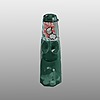HOME | DD
 MOAB23 — APE-552
MOAB23 — APE-552

Published: 2014-06-02 09:21:21 +0000 UTC; Views: 5576; Favourites: 47; Downloads: 0
Redirect to original
Description
Manufactured by Marros Systems, the APE-552 is a model of anti-proton engine developed for the Pandoran-class of starship used by the Escean Interstellar Navy.
A single Pandoran is fitted with eight APE units arranged in two pairs and two clusters of four. Each individual unit is equipped with a primary engine, sixteen Ionic Orbital Manoeuvring System thrusters and twenty-eight emergency ejection thrusters.
The APE is a second-generation antimatter engine used for interplanetary and combat propulsion, capable of providing instantaneous high-thrust not possible with other engine types. With all APEs active, a Pandoran can achieve 95% of light speed in the Home Dimension.
An APE unit uses anti-proton annihilation to provide thrust. Anti-protons collected from particle accelerator installations are transferred to orbital depots and eventually loaded into airless titanium spheres surrounded by supercooled jackets inlaid with a magnetic matrix. When initiated a flow of anti-protons, controlled by magnetic flux, is injected into a reaction chamber. Hydrogen is likewise pumped in to instigate annihilation, again controlled by a powerful magnetic field. This field directs the flow of energy into an exhaust opening where gaseous vespomide is injected as fuel enhancement to boost the overall thrust of the burn. At full combat thrust, the flare of an APE engine can extend over a kilometre and exceed one million degrees.
To provide orbital manoeuvring an APE is equipped with a dual ring of ionic thrusters surrounding the primary exhaust port, which work in tandem with other IOMS thrusters for docking manoeuvres or course adjustments. These thrusters receive power from one of two onboard burner reactors, which likewise supply primary power to the anti-proton system. Liquid hydrogen is drawn from refrigeration plants within the engineering section and pumped into the engine’s supercoolant storage tanks to maintain a constant near-zero temperature. Waste heat from the reaction chamber is bled off through an array of radiator panels on the upper surface of the engine cowling.
To accommodate for the potentially catastrophic failure of an engine, such as a loss of power or damage to the magnetic containment system, each APE unit can be jettisoned. Relying on onboard secondary power, the engine is first released from its mounting system and pushed clear by a jet of compressed air, at which point a dual row of ionic thrusters boost the separated unit away from the starship. Additional manoeuvring is required to increase distance between the vessel and the damaged engine.
Should magnetic containment or coolant fail through power loss or damage the anti-protons will inevitably interact with their storage sphere and annihilate it, leading to a chain reaction event capable of destroying the vessel. Following ejection, damage from an exploding engine is increasingly limited to propelled debris only as distance increases, which can be accommodated by the ship’s shielding and armour.
Related content
Comments: 2

Well this sheds new light into the starship category.
👍: 0 ⏩: 1

Need to work on my starships a little more, along with the dimensional gate design and a cross-section of my burner reactor.
👍: 0 ⏩: 0



















